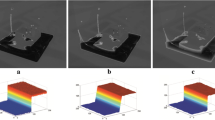Abstract
Realistic and real-time simulation of fluid animation is widely used to the application of virtual reality(VR) such as VR game, special effect in film, augmented reality (AR) and so on. However, fast simulation of complex fluid animation problem such as free interaction surface and high impact requires a large number of both physical computations and time steps. It in turn leads to high computational cost. In order to improve the problem, we design a fast tool to accelerate and simulate fluid animation using multi-node graphics processing units clusters. In this paper, we present a fluid animation model tool for VR application based on multi-GPU cluster. The model method of position-based fluid (PBF) is implemented on our tool, and some strategies for GPUs optimizations are applied to parallel system based on the character of hardware. We first present an efficient data structure for speeding up memory access. Then, an optimized parallel framework is designed to get higher performance. We adjust the size of grid sptial index, reducing the access and thread synchronization during the neighborhood search, which greatly improve the efficiency on GPU. The key work of extending the PBF method from single GPU to GPU clusters, a spatial decomposition strategy is presented based on Orthogonal Recursive Bisection(ORB) model. Finally, an effective VR tool for real-time fluid animation modeling on the GPUs cluster is designed which can create various vivid animation. The performance and efficiency of our method are demonstrated using multiple VR scenes.













Similar content being viewed by others
References
Anderson JA, Lorenz CD, Travesset A (2008) General purpose molecular dynamics simulations fully implemented on graphics processing units. J Comput Phys 227:5342–5359
Band S, Gissler C, Peer A, Teschner M (2018) MLS pressure extrapolation for the boundary handling divergence-free SPH. Workshop on virtual reality interaction and physical simulation VRIPHYS
Becker M, Teschner M (2007) Weakly compressible SPH for free surface flows[C]. In: Proceedings of the 2007 ACM SIGGRAPH/Eurographics symposium on Computer animation. Eurographics Association, pp 209–217
Bender J, Koschier D, Charrier P (2014) Weberd.: position-based simulation of continuous materials. Comput Graph 44(0):1–10
Bender J, Müller M, Otaduy MA, Teschner M, Macklin M (2014) A survey on position-based simulation methods in computer graphics. Comput Graph Forum 33(6):228–251
Cornelis J, Bender J, Gissler C, Ihmsen M (2019) An optimized source term formulation for incompressible SPH. Vis Comput 35(4):579–590
Deng W, Xu J, Zhao H (2019) An improved ant colony optimization algorithm based on hybrid strategies for scheduling problem. IEEE ACCESS, https://doi.org/10.1109/ACCESS.2019.2897580
Diziol R, Bender J, Bayer D (2011) Robust real-time deformation of incompressible surface meshes. In: Proceedings of the 2011 ACM SIGGRAPH/Eurographics symposium on computer animation, SCA ’11, Eurographics association, pp 1–10
Ferrari A, Dumbser M, Toro EF, Armanini A (2009) A new 3D parallel SPH scheme for free surface flows. Comput Fluids 38:1203–1217
Frezzotti A, Ghiroldi GP, Gibelli L (2011) Solving the Boltzmann equation on GPUs. Comput Phys Commun 182:2445–2453
Herault A, Bilotta G, Dalrymple RA (2010) SPH on GPU with CUDA[J]. J Hydraul Res 48(S1):74–79
Ihmsen M, Akinci N, Becker M, Teschner M (2011) A parallel SPH implementation on multi-core CPUs. Comput Graph Forum 30(1):99–112
Kalojanov J, Slusallek P (2009) A parallel algorithm for construction of uniform grids. In: Proceedings of the ACM conference on high performance graphics, pp 23–28
Liu J, Wu J, Panda DK (2004) High performance RDMA-based MPI implementation over InfiniBand[J]. Int J Parallel Prog 32(3):167–198
Macklin M, Müller M (2013) Position based fluids. ACM Trans Graph 32 (4):104:1–104:12
Markus I, Nadir A, Markus B (2010) A parallel sph implementation on multi-core cpus. Comput Graph Forum 30:99–112
Monaghan JJ (1994) Simulating free surface flows with sph. J Comput Phys 110 (2):399–406
Moulinec C, Issa R, Marongiu J-C, Violeau D (2008) Parallel 3-D SPH simulations. Comput Model Eng Sci 25(3):133–148
Müller M, Heidelberger B, Hennix M, et al (2007) Position based dynamics[J]. J Vis Commun Image Represent 18(2):109–118
Potluri S, Wang H, Bureddy D, et al (2012) Optimizing MPI communication on multi-GPU systems using CUDA inter-process communication[C]. In: 2012 IEEE 26th International parallel and distributed processing symposium workshops & PhD forum (IPDPSW). IEEE, pp 1848–1857
Solenthaler B, Pajarola R (2009) Predictive-corrective incompressible SPH[C]. ACM Trans Graph (TOG) ACM 28(3):40
Wang H, Potluri S, Luo M, et al (2011) Optimized non-contiguous MPI datatype communication for GPU clusters: design, implementation and evaluation with MVAPICH2[ C]. In: 2011 IEEE International conference on cluster computing (CLUSTER). IEEE, pp 308–316
Zhang F, Xukun S, Xiang L, et al (2013) A particle model for fluid simulation on the multi-graphics processing unit. Int J Numer Modell: Electron Netw Dev Fields 26(4):397–414
Zhang F, Zhaowei W, Jian C, et al (2017) A fast framework construction and visulization method for particle-based fluid. EUBASIP Journal on Image and Video Processing (2017), 79
Acknowledgements
This paper is supported Ministry of Education Humanities and Social Sciences Foundation (No.19YJC760150), Beijing Natural Science Foundation (No.4182018, No.4194076), Beijing Social Science Foundation (No.18YTC038),Beijing Urban Governance Research Center The open funding project of State Key Laboratory of Virtual Reality Technology and Systems, Beihang University (No.VRLAB2018A05), National Natural Science Foundation of China(No.61402016,No.61502168), Beijing Youth Talent Foundation (No.2016000026833ZK09), NCUT Foundation (No.XN018001).
Author information
Authors and Affiliations
Corresponding author
Additional information
Publisher’s note
Springer Nature remains neutral with regard to jurisdictional claims in published maps and institutional affiliations.
Rights and permissions
About this article
Cite this article
Zhang, F., Wei, Q. & Xu, L. An fast simulation tool for fluid animation in VR application based on GPUs. Multimed Tools Appl 79, 16683–16706 (2020). https://doi.org/10.1007/s11042-019-08002-4
Received:
Revised:
Accepted:
Published:
Issue Date:
DOI: https://doi.org/10.1007/s11042-019-08002-4




